Supply-Side and Demand-Side Cost Sharing in Healthcare: A Report
VerifiedAdded on 2022/09/27
|7
|1846
|23
Report
AI Summary
This report examines supply-side and demand-side cost sharing in healthcare, drawing on the work of Ellis and McGuire (1993). It explores how these strategies, which include demand-side cost sharing (increased patient payments) and supply-side cost sharing (modifying provider incentives), can control healthcare costs. The report synthesizes existing research, including studies by Burner et al. (1992), Arrow (1963), and Zeckhauser (1970), to evaluate the strengths and limitations of each approach. It highlights the importance of protecting patients from financial risks, ensuring fairness to providers and consumers, and promoting efficient healthcare delivery. The report also provides recommendations for improving the healthcare system by modifying incentives and providing tools to the private sector, ultimately aiming to reduce moral hazard and enhance the overall quality and accessibility of healthcare services. The analysis includes a discussion of the effects of cost sharing policies on moral hazard, particularly within the context of Medicare and private health insurance schemes.
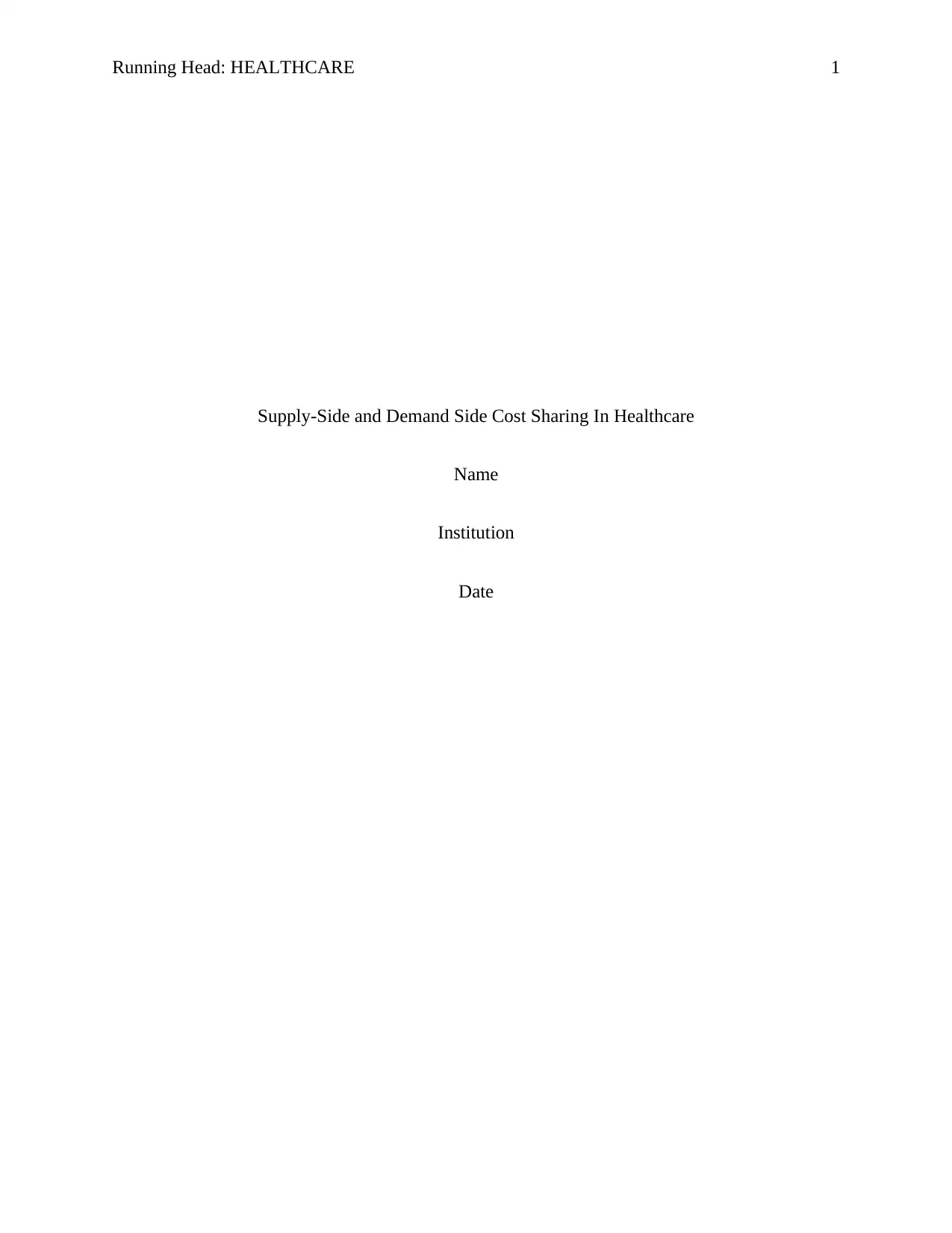
Running Head: HEALTHCARE 1
Supply-Side and Demand Side Cost Sharing In Healthcare
Name
Institution
Date
Supply-Side and Demand Side Cost Sharing In Healthcare
Name
Institution
Date
Paraphrase This Document
Need a fresh take? Get an instant paraphrase of this document with our AI Paraphraser
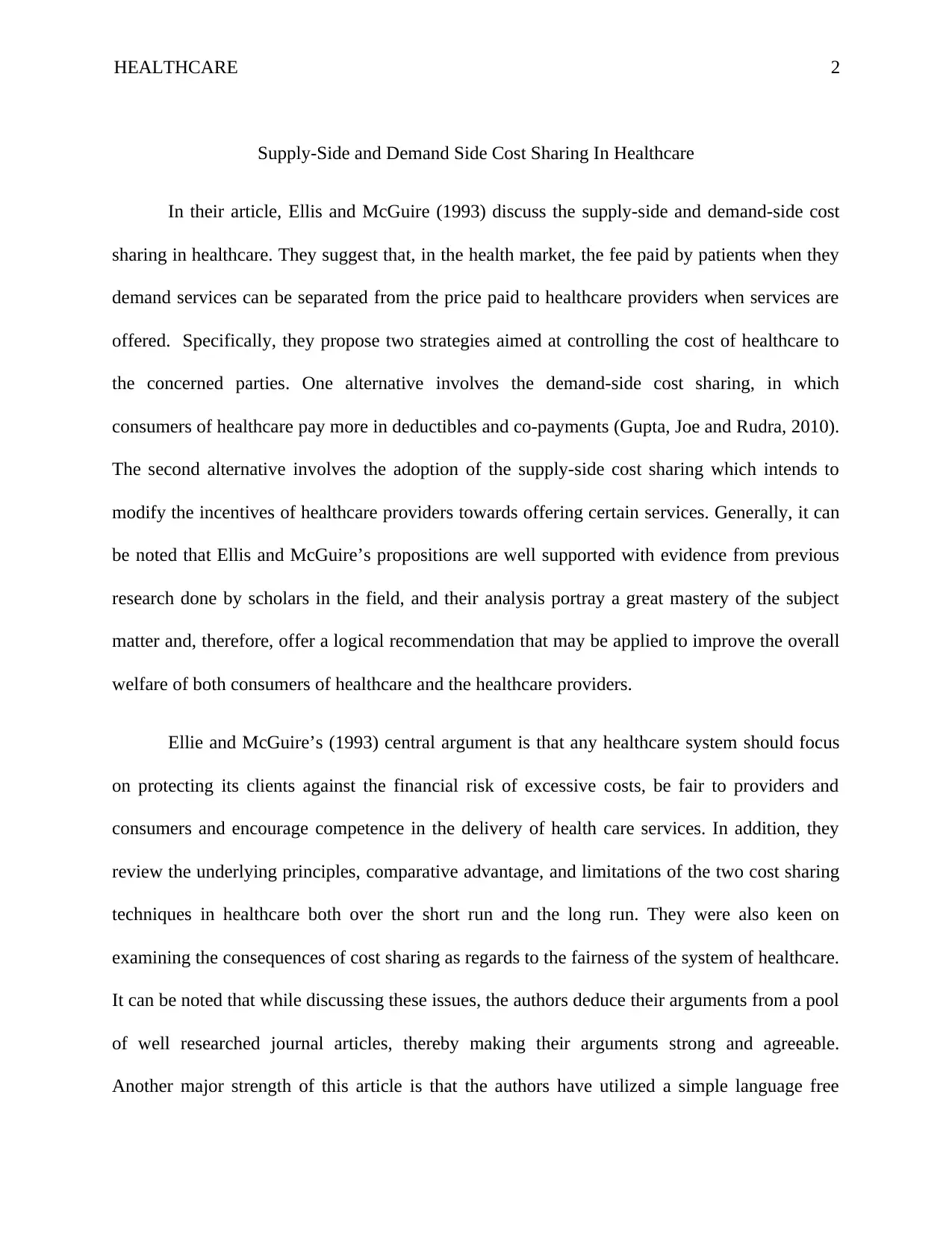
HEALTHCARE 2
Supply-Side and Demand Side Cost Sharing In Healthcare
In their article, Ellis and McGuire (1993) discuss the supply-side and demand-side cost
sharing in healthcare. They suggest that, in the health market, the fee paid by patients when they
demand services can be separated from the price paid to healthcare providers when services are
offered. Specifically, they propose two strategies aimed at controlling the cost of healthcare to
the concerned parties. One alternative involves the demand-side cost sharing, in which
consumers of healthcare pay more in deductibles and co-payments (Gupta, Joe and Rudra, 2010).
The second alternative involves the adoption of the supply-side cost sharing which intends to
modify the incentives of healthcare providers towards offering certain services. Generally, it can
be noted that Ellis and McGuire’s propositions are well supported with evidence from previous
research done by scholars in the field, and their analysis portray a great mastery of the subject
matter and, therefore, offer a logical recommendation that may be applied to improve the overall
welfare of both consumers of healthcare and the healthcare providers.
Ellie and McGuire’s (1993) central argument is that any healthcare system should focus
on protecting its clients against the financial risk of excessive costs, be fair to providers and
consumers and encourage competence in the delivery of health care services. In addition, they
review the underlying principles, comparative advantage, and limitations of the two cost sharing
techniques in healthcare both over the short run and the long run. They were also keen on
examining the consequences of cost sharing as regards to the fairness of the system of healthcare.
It can be noted that while discussing these issues, the authors deduce their arguments from a pool
of well researched journal articles, thereby making their arguments strong and agreeable.
Another major strength of this article is that the authors have utilized a simple language free
Supply-Side and Demand Side Cost Sharing In Healthcare
In their article, Ellis and McGuire (1993) discuss the supply-side and demand-side cost
sharing in healthcare. They suggest that, in the health market, the fee paid by patients when they
demand services can be separated from the price paid to healthcare providers when services are
offered. Specifically, they propose two strategies aimed at controlling the cost of healthcare to
the concerned parties. One alternative involves the demand-side cost sharing, in which
consumers of healthcare pay more in deductibles and co-payments (Gupta, Joe and Rudra, 2010).
The second alternative involves the adoption of the supply-side cost sharing which intends to
modify the incentives of healthcare providers towards offering certain services. Generally, it can
be noted that Ellis and McGuire’s propositions are well supported with evidence from previous
research done by scholars in the field, and their analysis portray a great mastery of the subject
matter and, therefore, offer a logical recommendation that may be applied to improve the overall
welfare of both consumers of healthcare and the healthcare providers.
Ellie and McGuire’s (1993) central argument is that any healthcare system should focus
on protecting its clients against the financial risk of excessive costs, be fair to providers and
consumers and encourage competence in the delivery of health care services. In addition, they
review the underlying principles, comparative advantage, and limitations of the two cost sharing
techniques in healthcare both over the short run and the long run. They were also keen on
examining the consequences of cost sharing as regards to the fairness of the system of healthcare.
It can be noted that while discussing these issues, the authors deduce their arguments from a pool
of well researched journal articles, thereby making their arguments strong and agreeable.
Another major strength of this article is that the authors have utilized a simple language free
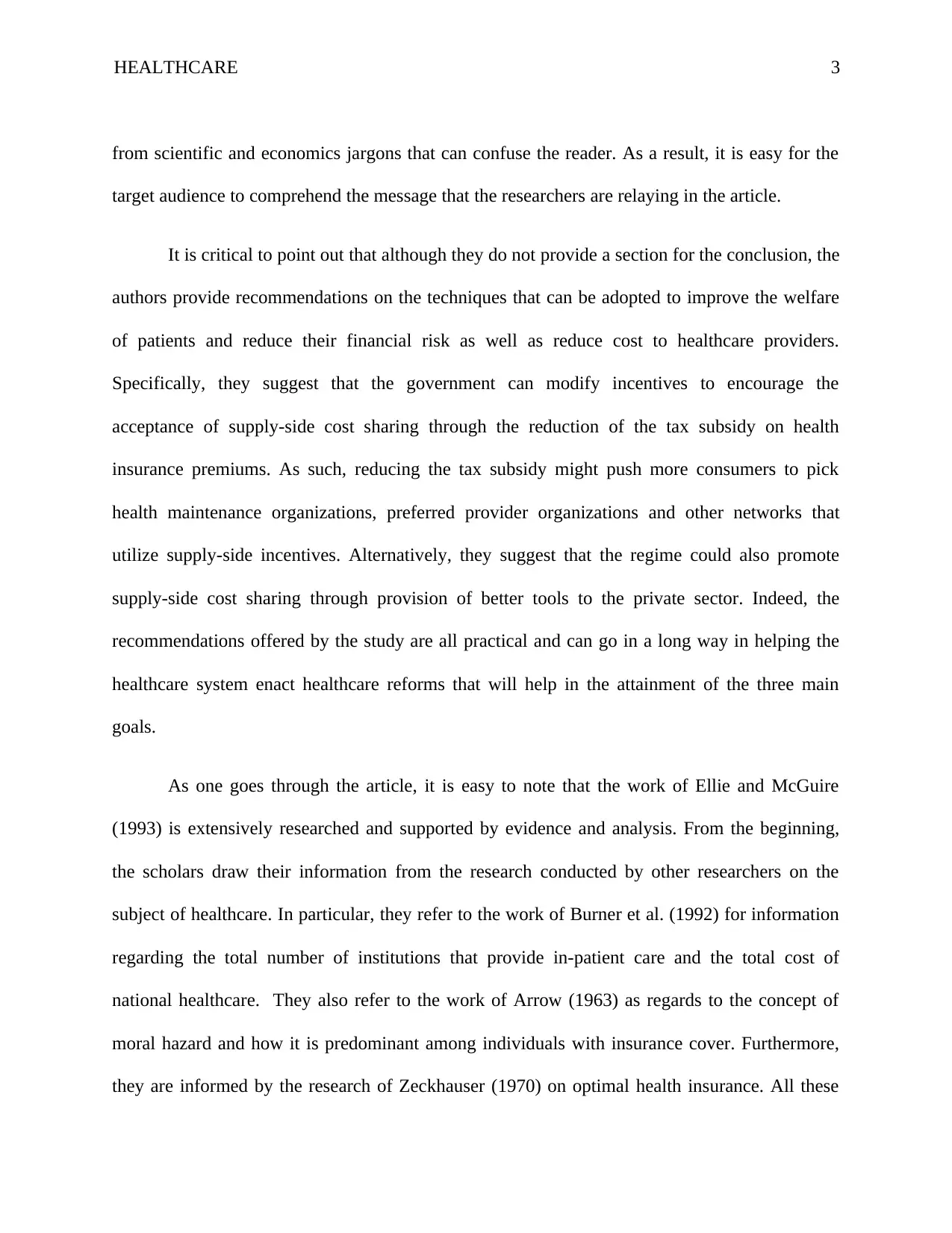
HEALTHCARE 3
from scientific and economics jargons that can confuse the reader. As a result, it is easy for the
target audience to comprehend the message that the researchers are relaying in the article.
It is critical to point out that although they do not provide a section for the conclusion, the
authors provide recommendations on the techniques that can be adopted to improve the welfare
of patients and reduce their financial risk as well as reduce cost to healthcare providers.
Specifically, they suggest that the government can modify incentives to encourage the
acceptance of supply-side cost sharing through the reduction of the tax subsidy on health
insurance premiums. As such, reducing the tax subsidy might push more consumers to pick
health maintenance organizations, preferred provider organizations and other networks that
utilize supply-side incentives. Alternatively, they suggest that the regime could also promote
supply-side cost sharing through provision of better tools to the private sector. Indeed, the
recommendations offered by the study are all practical and can go in a long way in helping the
healthcare system enact healthcare reforms that will help in the attainment of the three main
goals.
As one goes through the article, it is easy to note that the work of Ellie and McGuire
(1993) is extensively researched and supported by evidence and analysis. From the beginning,
the scholars draw their information from the research conducted by other researchers on the
subject of healthcare. In particular, they refer to the work of Burner et al. (1992) for information
regarding the total number of institutions that provide in-patient care and the total cost of
national healthcare. They also refer to the work of Arrow (1963) as regards to the concept of
moral hazard and how it is predominant among individuals with insurance cover. Furthermore,
they are informed by the research of Zeckhauser (1970) on optimal health insurance. All these
from scientific and economics jargons that can confuse the reader. As a result, it is easy for the
target audience to comprehend the message that the researchers are relaying in the article.
It is critical to point out that although they do not provide a section for the conclusion, the
authors provide recommendations on the techniques that can be adopted to improve the welfare
of patients and reduce their financial risk as well as reduce cost to healthcare providers.
Specifically, they suggest that the government can modify incentives to encourage the
acceptance of supply-side cost sharing through the reduction of the tax subsidy on health
insurance premiums. As such, reducing the tax subsidy might push more consumers to pick
health maintenance organizations, preferred provider organizations and other networks that
utilize supply-side incentives. Alternatively, they suggest that the regime could also promote
supply-side cost sharing through provision of better tools to the private sector. Indeed, the
recommendations offered by the study are all practical and can go in a long way in helping the
healthcare system enact healthcare reforms that will help in the attainment of the three main
goals.
As one goes through the article, it is easy to note that the work of Ellie and McGuire
(1993) is extensively researched and supported by evidence and analysis. From the beginning,
the scholars draw their information from the research conducted by other researchers on the
subject of healthcare. In particular, they refer to the work of Burner et al. (1992) for information
regarding the total number of institutions that provide in-patient care and the total cost of
national healthcare. They also refer to the work of Arrow (1963) as regards to the concept of
moral hazard and how it is predominant among individuals with insurance cover. Furthermore,
they are informed by the research of Zeckhauser (1970) on optimal health insurance. All these
⊘ This is a preview!⊘
Do you want full access?
Subscribe today to unlock all pages.

Trusted by 1+ million students worldwide
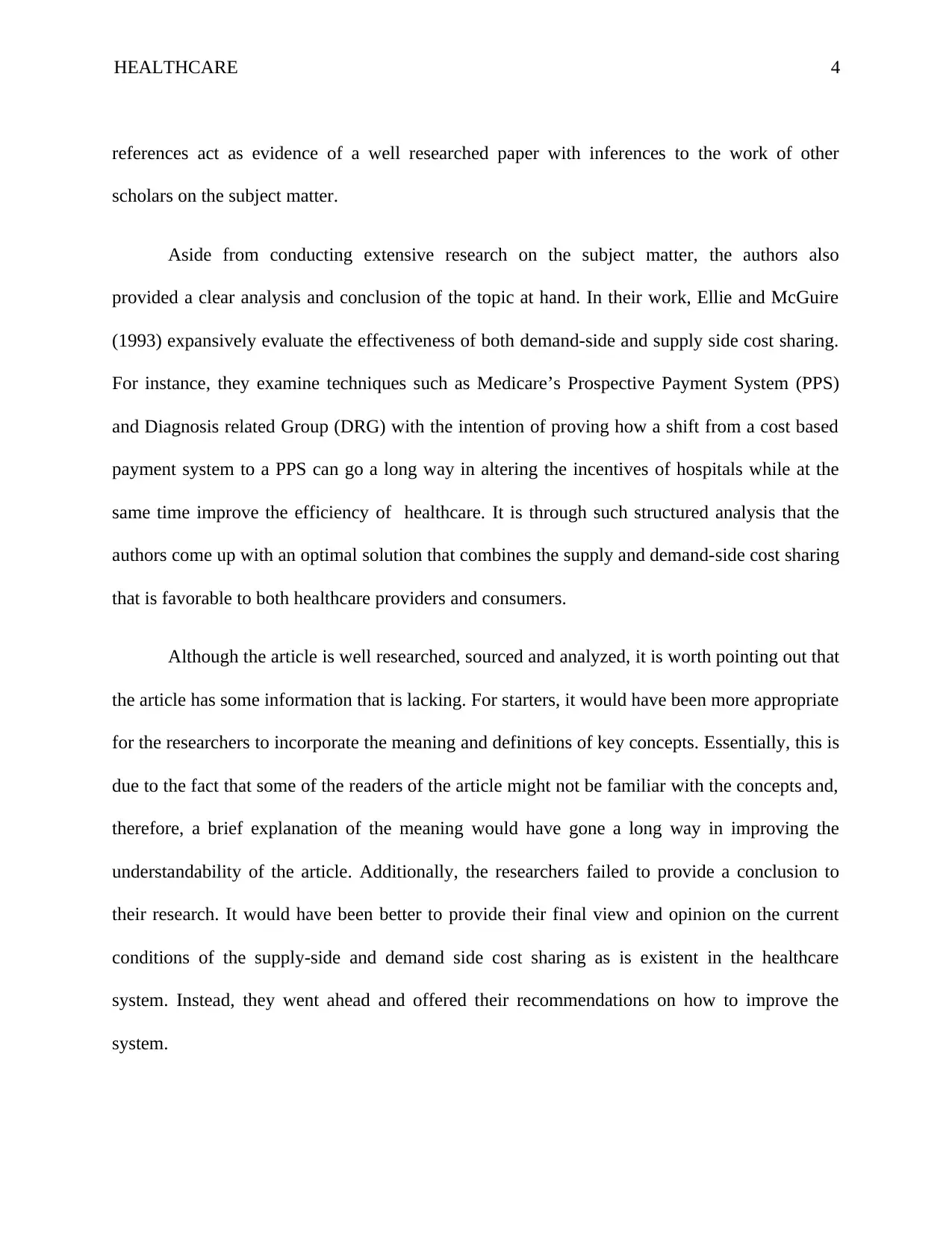
HEALTHCARE 4
references act as evidence of a well researched paper with inferences to the work of other
scholars on the subject matter.
Aside from conducting extensive research on the subject matter, the authors also
provided a clear analysis and conclusion of the topic at hand. In their work, Ellie and McGuire
(1993) expansively evaluate the effectiveness of both demand-side and supply side cost sharing.
For instance, they examine techniques such as Medicare’s Prospective Payment System (PPS)
and Diagnosis related Group (DRG) with the intention of proving how a shift from a cost based
payment system to a PPS can go a long way in altering the incentives of hospitals while at the
same time improve the efficiency of healthcare. It is through such structured analysis that the
authors come up with an optimal solution that combines the supply and demand-side cost sharing
that is favorable to both healthcare providers and consumers.
Although the article is well researched, sourced and analyzed, it is worth pointing out that
the article has some information that is lacking. For starters, it would have been more appropriate
for the researchers to incorporate the meaning and definitions of key concepts. Essentially, this is
due to the fact that some of the readers of the article might not be familiar with the concepts and,
therefore, a brief explanation of the meaning would have gone a long way in improving the
understandability of the article. Additionally, the researchers failed to provide a conclusion to
their research. It would have been better to provide their final view and opinion on the current
conditions of the supply-side and demand side cost sharing as is existent in the healthcare
system. Instead, they went ahead and offered their recommendations on how to improve the
system.
references act as evidence of a well researched paper with inferences to the work of other
scholars on the subject matter.
Aside from conducting extensive research on the subject matter, the authors also
provided a clear analysis and conclusion of the topic at hand. In their work, Ellie and McGuire
(1993) expansively evaluate the effectiveness of both demand-side and supply side cost sharing.
For instance, they examine techniques such as Medicare’s Prospective Payment System (PPS)
and Diagnosis related Group (DRG) with the intention of proving how a shift from a cost based
payment system to a PPS can go a long way in altering the incentives of hospitals while at the
same time improve the efficiency of healthcare. It is through such structured analysis that the
authors come up with an optimal solution that combines the supply and demand-side cost sharing
that is favorable to both healthcare providers and consumers.
Although the article is well researched, sourced and analyzed, it is worth pointing out that
the article has some information that is lacking. For starters, it would have been more appropriate
for the researchers to incorporate the meaning and definitions of key concepts. Essentially, this is
due to the fact that some of the readers of the article might not be familiar with the concepts and,
therefore, a brief explanation of the meaning would have gone a long way in improving the
understandability of the article. Additionally, the researchers failed to provide a conclusion to
their research. It would have been better to provide their final view and opinion on the current
conditions of the supply-side and demand side cost sharing as is existent in the healthcare
system. Instead, they went ahead and offered their recommendations on how to improve the
system.
Paraphrase This Document
Need a fresh take? Get an instant paraphrase of this document with our AI Paraphraser
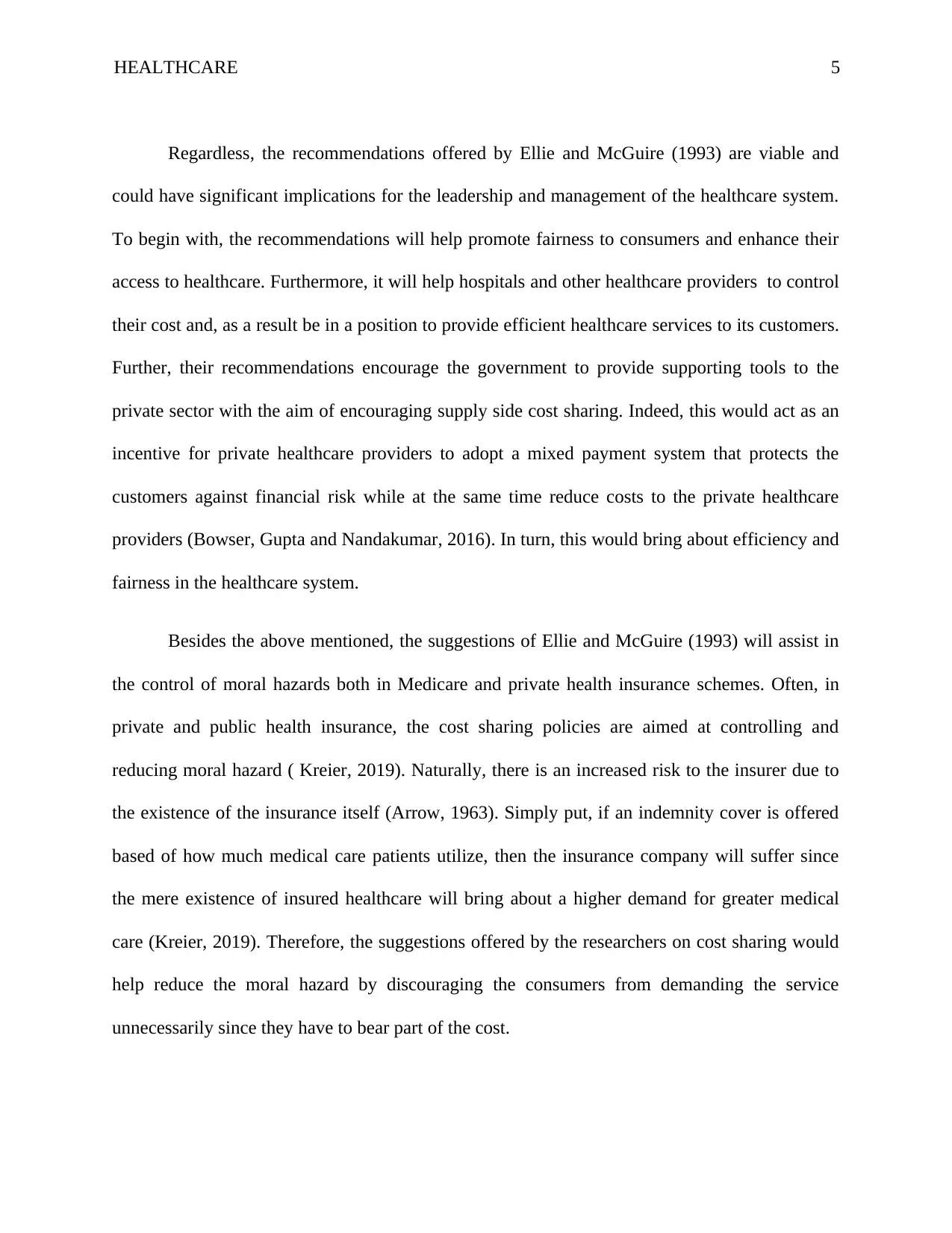
HEALTHCARE 5
Regardless, the recommendations offered by Ellie and McGuire (1993) are viable and
could have significant implications for the leadership and management of the healthcare system.
To begin with, the recommendations will help promote fairness to consumers and enhance their
access to healthcare. Furthermore, it will help hospitals and other healthcare providers to control
their cost and, as a result be in a position to provide efficient healthcare services to its customers.
Further, their recommendations encourage the government to provide supporting tools to the
private sector with the aim of encouraging supply side cost sharing. Indeed, this would act as an
incentive for private healthcare providers to adopt a mixed payment system that protects the
customers against financial risk while at the same time reduce costs to the private healthcare
providers (Bowser, Gupta and Nandakumar, 2016). In turn, this would bring about efficiency and
fairness in the healthcare system.
Besides the above mentioned, the suggestions of Ellie and McGuire (1993) will assist in
the control of moral hazards both in Medicare and private health insurance schemes. Often, in
private and public health insurance, the cost sharing policies are aimed at controlling and
reducing moral hazard ( Kreier, 2019). Naturally, there is an increased risk to the insurer due to
the existence of the insurance itself (Arrow, 1963). Simply put, if an indemnity cover is offered
based of how much medical care patients utilize, then the insurance company will suffer since
the mere existence of insured healthcare will bring about a higher demand for greater medical
care (Kreier, 2019). Therefore, the suggestions offered by the researchers on cost sharing would
help reduce the moral hazard by discouraging the consumers from demanding the service
unnecessarily since they have to bear part of the cost.
Regardless, the recommendations offered by Ellie and McGuire (1993) are viable and
could have significant implications for the leadership and management of the healthcare system.
To begin with, the recommendations will help promote fairness to consumers and enhance their
access to healthcare. Furthermore, it will help hospitals and other healthcare providers to control
their cost and, as a result be in a position to provide efficient healthcare services to its customers.
Further, their recommendations encourage the government to provide supporting tools to the
private sector with the aim of encouraging supply side cost sharing. Indeed, this would act as an
incentive for private healthcare providers to adopt a mixed payment system that protects the
customers against financial risk while at the same time reduce costs to the private healthcare
providers (Bowser, Gupta and Nandakumar, 2016). In turn, this would bring about efficiency and
fairness in the healthcare system.
Besides the above mentioned, the suggestions of Ellie and McGuire (1993) will assist in
the control of moral hazards both in Medicare and private health insurance schemes. Often, in
private and public health insurance, the cost sharing policies are aimed at controlling and
reducing moral hazard ( Kreier, 2019). Naturally, there is an increased risk to the insurer due to
the existence of the insurance itself (Arrow, 1963). Simply put, if an indemnity cover is offered
based of how much medical care patients utilize, then the insurance company will suffer since
the mere existence of insured healthcare will bring about a higher demand for greater medical
care (Kreier, 2019). Therefore, the suggestions offered by the researchers on cost sharing would
help reduce the moral hazard by discouraging the consumers from demanding the service
unnecessarily since they have to bear part of the cost.
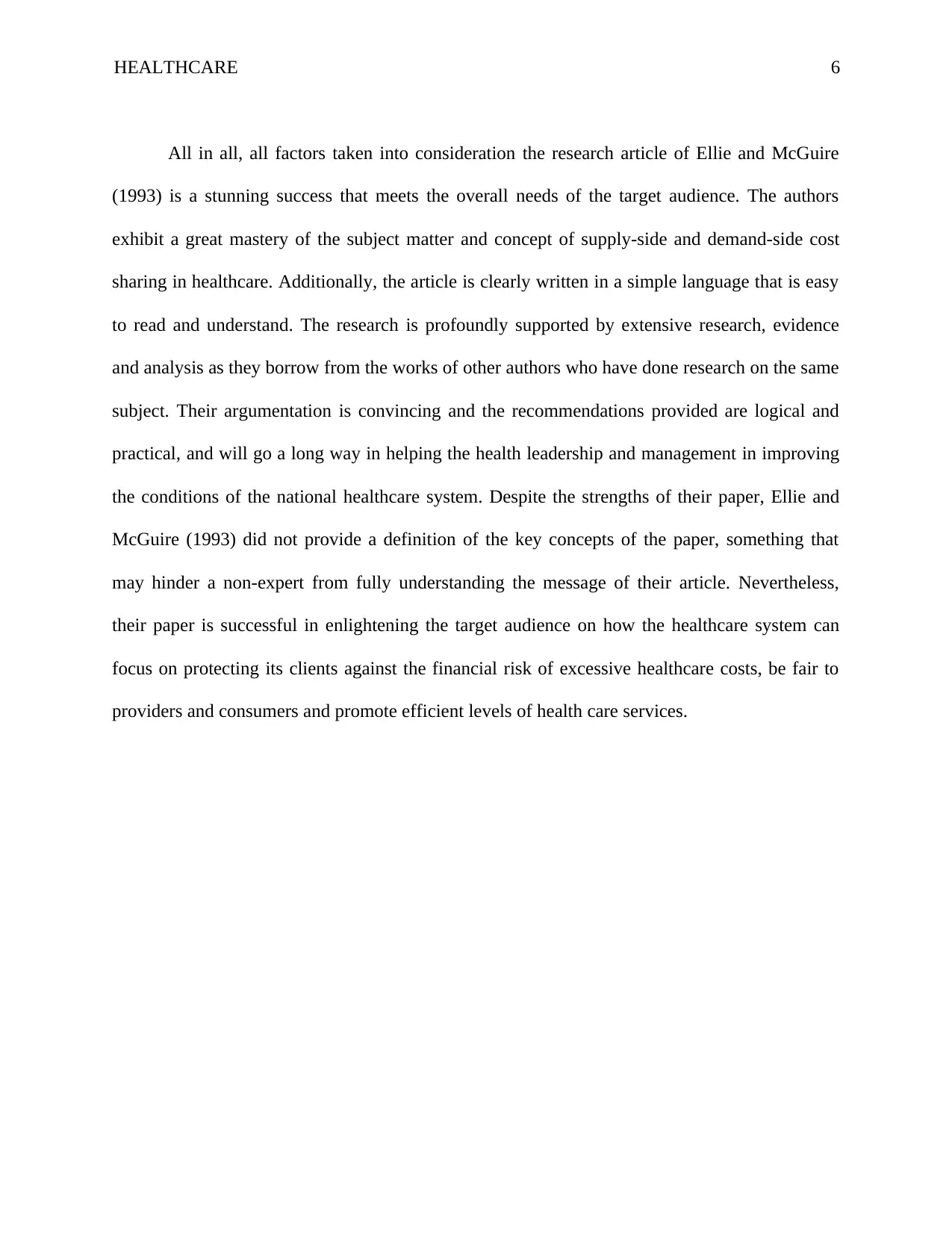
HEALTHCARE 6
All in all, all factors taken into consideration the research article of Ellie and McGuire
(1993) is a stunning success that meets the overall needs of the target audience. The authors
exhibit a great mastery of the subject matter and concept of supply-side and demand-side cost
sharing in healthcare. Additionally, the article is clearly written in a simple language that is easy
to read and understand. The research is profoundly supported by extensive research, evidence
and analysis as they borrow from the works of other authors who have done research on the same
subject. Their argumentation is convincing and the recommendations provided are logical and
practical, and will go a long way in helping the health leadership and management in improving
the conditions of the national healthcare system. Despite the strengths of their paper, Ellie and
McGuire (1993) did not provide a definition of the key concepts of the paper, something that
may hinder a non-expert from fully understanding the message of their article. Nevertheless,
their paper is successful in enlightening the target audience on how the healthcare system can
focus on protecting its clients against the financial risk of excessive healthcare costs, be fair to
providers and consumers and promote efficient levels of health care services.
All in all, all factors taken into consideration the research article of Ellie and McGuire
(1993) is a stunning success that meets the overall needs of the target audience. The authors
exhibit a great mastery of the subject matter and concept of supply-side and demand-side cost
sharing in healthcare. Additionally, the article is clearly written in a simple language that is easy
to read and understand. The research is profoundly supported by extensive research, evidence
and analysis as they borrow from the works of other authors who have done research on the same
subject. Their argumentation is convincing and the recommendations provided are logical and
practical, and will go a long way in helping the health leadership and management in improving
the conditions of the national healthcare system. Despite the strengths of their paper, Ellie and
McGuire (1993) did not provide a definition of the key concepts of the paper, something that
may hinder a non-expert from fully understanding the message of their article. Nevertheless,
their paper is successful in enlightening the target audience on how the healthcare system can
focus on protecting its clients against the financial risk of excessive healthcare costs, be fair to
providers and consumers and promote efficient levels of health care services.
⊘ This is a preview!⊘
Do you want full access?
Subscribe today to unlock all pages.

Trusted by 1+ million students worldwide
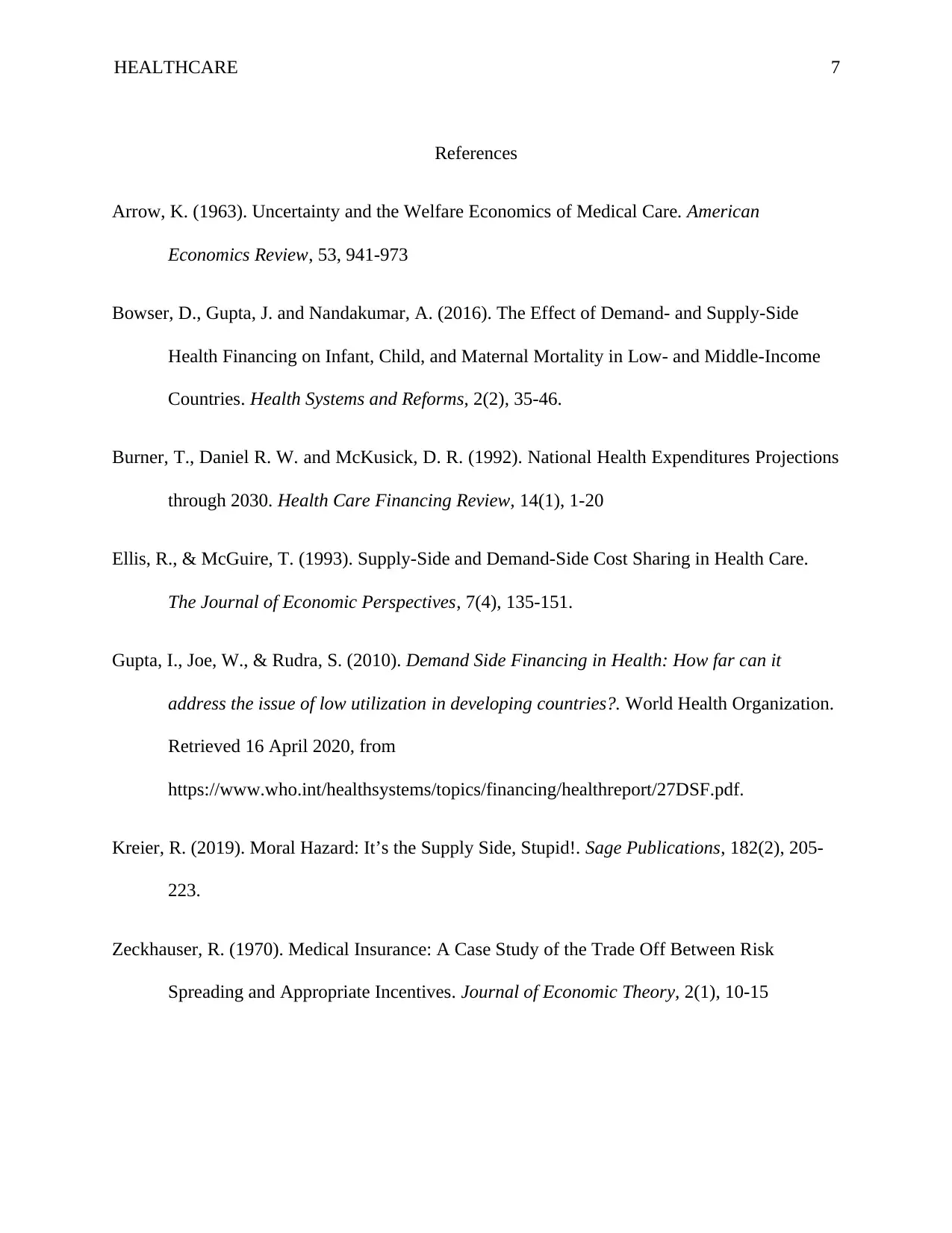
HEALTHCARE 7
References
Arrow, K. (1963). Uncertainty and the Welfare Economics of Medical Care. American
Economics Review, 53, 941-973
Bowser, D., Gupta, J. and Nandakumar, A. (2016). The Effect of Demand- and Supply-Side
Health Financing on Infant, Child, and Maternal Mortality in Low- and Middle-Income
Countries. Health Systems and Reforms, 2(2), 35-46.
Burner, T., Daniel R. W. and McKusick, D. R. (1992). National Health Expenditures Projections
through 2030. Health Care Financing Review, 14(1), 1-20
Ellis, R., & McGuire, T. (1993). Supply-Side and Demand-Side Cost Sharing in Health Care.
The Journal of Economic Perspectives, 7(4), 135-151.
Gupta, I., Joe, W., & Rudra, S. (2010). Demand Side Financing in Health: How far can it
address the issue of low utilization in developing countries?. World Health Organization.
Retrieved 16 April 2020, from
https://www.who.int/healthsystems/topics/financing/healthreport/27DSF.pdf.
Kreier, R. (2019). Moral Hazard: It’s the Supply Side, Stupid!. Sage Publications, 182(2), 205-
223.
Zeckhauser, R. (1970). Medical Insurance: A Case Study of the Trade Off Between Risk
Spreading and Appropriate Incentives. Journal of Economic Theory, 2(1), 10-15
References
Arrow, K. (1963). Uncertainty and the Welfare Economics of Medical Care. American
Economics Review, 53, 941-973
Bowser, D., Gupta, J. and Nandakumar, A. (2016). The Effect of Demand- and Supply-Side
Health Financing on Infant, Child, and Maternal Mortality in Low- and Middle-Income
Countries. Health Systems and Reforms, 2(2), 35-46.
Burner, T., Daniel R. W. and McKusick, D. R. (1992). National Health Expenditures Projections
through 2030. Health Care Financing Review, 14(1), 1-20
Ellis, R., & McGuire, T. (1993). Supply-Side and Demand-Side Cost Sharing in Health Care.
The Journal of Economic Perspectives, 7(4), 135-151.
Gupta, I., Joe, W., & Rudra, S. (2010). Demand Side Financing in Health: How far can it
address the issue of low utilization in developing countries?. World Health Organization.
Retrieved 16 April 2020, from
https://www.who.int/healthsystems/topics/financing/healthreport/27DSF.pdf.
Kreier, R. (2019). Moral Hazard: It’s the Supply Side, Stupid!. Sage Publications, 182(2), 205-
223.
Zeckhauser, R. (1970). Medical Insurance: A Case Study of the Trade Off Between Risk
Spreading and Appropriate Incentives. Journal of Economic Theory, 2(1), 10-15
1 out of 7
Your All-in-One AI-Powered Toolkit for Academic Success.
+13062052269
info@desklib.com
Available 24*7 on WhatsApp / Email
![[object Object]](/_next/static/media/star-bottom.7253800d.svg)
Unlock your academic potential
Copyright © 2020–2025 A2Z Services. All Rights Reserved. Developed and managed by ZUCOL.

